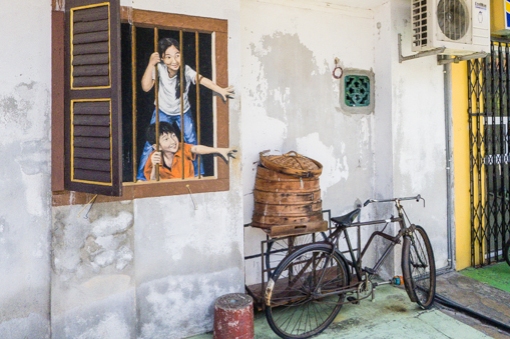On our way to Petaling Jaya (aka PJ, see earlier posts here, here and here), we discussed eating durian, the king of fruits, at length in the car. Neither one of us find the smell of the fruit as offensive or revolting as many people do. I(Chris) had it before and recognized (but cannot say appreciate) its peculiar and strong aroma. Nor are we fans of this fruit since it is hard to find it in North America and even harder now in Europe. So as dessert, J suggested that we try some durian at one of the stands on a nearby street.

This is how Wikipedia describes the aroma of durian:
The edible flesh emits a distinctive odour that is strong and penetrating even when the husk is intact. Some people regard the durian as having a pleasantly sweet fragrance; others find the aroma overpowering and revolting. The smell evokes reactions from deep appreciation to intense disgust, and has been described variously as rotten onions, turpentine, and raw sewage. The persistence of its odour has led to the fruit’s banishment from certain hotels and public transportation in Southeast Asia.
One of our hotels prohibit durian on its premises.

The durian stands are located on Jalan SS2/65 and at the corner with Jalan SS2/24, behind the police station, just down the street from the night market. Apparently, they are really famous within Malaysia and possibly internationally, as we found numerous references to the stands online.

One of the stands started the concept of all-you-can-eat durian buffet charging around RM15 per person. Our friend J who once lived on a farm and knows quite a bit about durian suggested that we forgo the buffet option as we should try the good stuff. The name durian comes from the Malay word duri (thorn).

We had no idea (although it is not surprising) that durian comes in so many different varieties. And this is the first time where we saw different varieties being sold separately and at vastly different prices. The varieties have names like Musang King, XO, Thracka, Jan Tong, red prawn, and various D numbers. The fruits are sold by weight and the rate for each variety changes daily depending on supply and season. The vendors have really done a good job in properly differentiating their products and generating a demand that can command a higher price.

We sat down at one of the tables of “King of the King”, Ah Chun was the manager. On the table were gloves and tissues, and the stand provides water since the flavor is so intense. We do not know of any fruit which requires water to wash it down.

J chatted with the vendors and selected a variety – D24 – for the four of us. Supposedly, each variety has a characteristic taste and regular eaters have their preferred varieties. Our fruit was about 2 kg and the assistant opened it for us in less than 20 seconds.

We wanted to try a sweet one but the first one was according to J not sweet enough. So she returned it and complained, and the assistant opened another one for us.

The taste was indeed intense, onion-like, nutty, slightly sweet, becoming alcoholic towards the seed, moist, soft and velvety. We think the foul smell appears only if the fruit is opened and have been left lying around.

The most popular and thus expensive variety is the Musang King (貓山皇) which had an asking price of RM60 per kg that night. This variety is recognizable by, among other special features, a characteristic star-shaped pattern at the bottom of the fruit. This practice encourages connoisseurship and is a great way to market this fruit and benefits the entire industry !

A popular drink is fresh coconut juice – it supposedly counters the heat (traditional Chinese medicine concept) of the durian.

What a great evening of adventurous eating !




















 .
.




























































